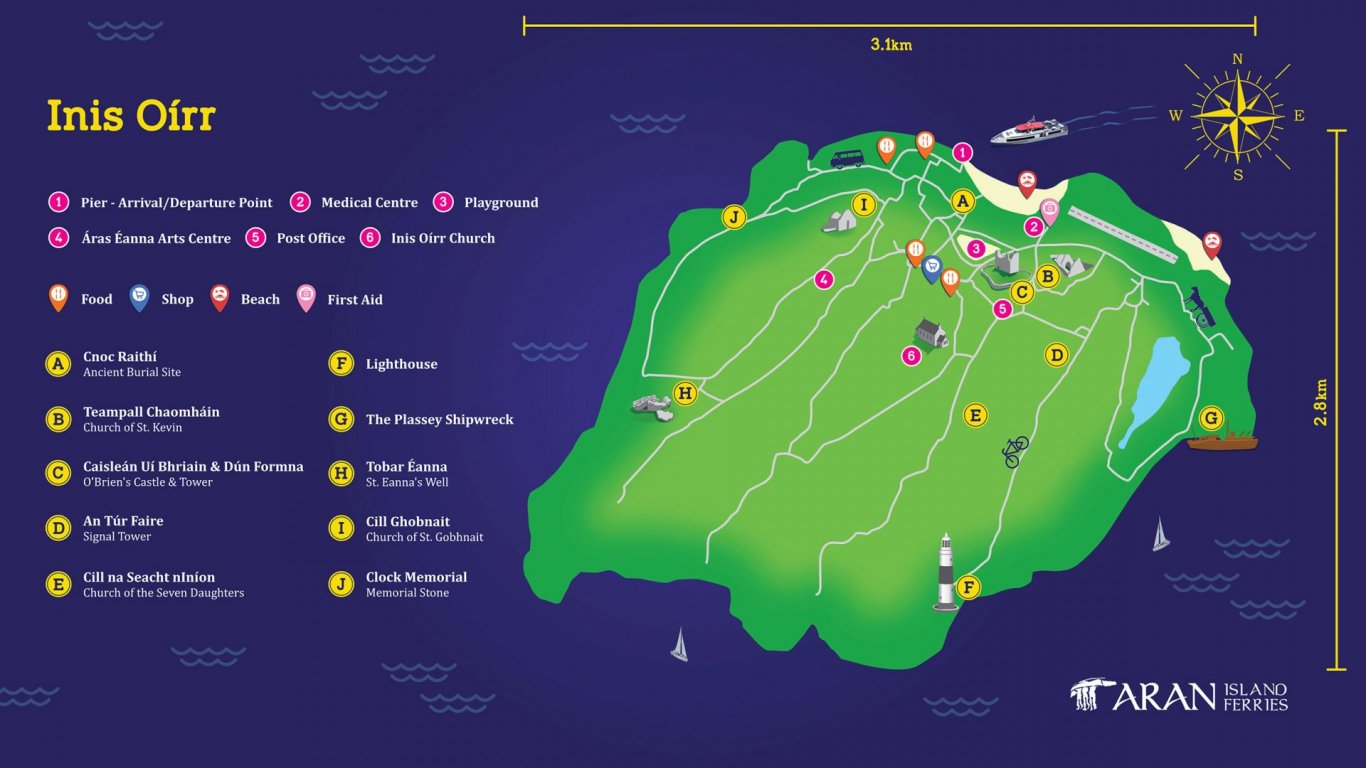Inis Oírr (Inisheer) for Beginners
Ask anyone on the west coast of Ireland what are the best day trips out of Galway and they’re bound to mention the Aran Islands. Its an iconic destination, full of fun and adventure regardless of the season.
If you have decided to add the Aran Islands to your bucket list this year, read on to find out more about the lesser known island of Inis Oírr (Inisheer).
Inis Oírr (Inisheer): The Facts
Inis Oírr (Anglicised as Inisheer) takes its name from its location too – ‘Oírr’ or ‘Thiar’ means easterly, and it is the last island in the little chain. It is the second most populous island, with a population of just 350. Comprising five small villages, the island has been inhabited since at least 1500 BC, as evidenced by the monuments.
Transport on Inis Oírr
The island has some small hills. Either rent a bike at the pier or take a leisurely walk. Alternatively, there are pony and trap carriers who can take you on tour. Trap tours are known for the friendly drivers, often native islanders, who show you the sights and share the stories of the island, often through their first-hand experience.
Language on Inis Oírr
The island's small population swells in the summer months as students flock to the Gaeltacht area to live and learn as Gaeilge. There is one school, Coláiste Ghobnait, which services secondary-level pupils. As all activities are carried out in the Irish language, the island is a haven for Irish language students of all levels, and visitors come from all corners of the world.
Culture on Inis Oírr
Inis Oírr is home to six designated national monuments, churches, castles, and graves. The island is steeped in history and is full of folklore, with many tales and legends focusing on the religious figures who sought escape and solitude on her shores. Caomhán of Inis Oírr is the island's patron saint.
Sport on Inis Oírr
The island has two Green Coast Awards in recognition of the cleanliness and safety of the beaches for swimming and watersports. An Trá and Trá na Caoraigh are stunning white sand stretches which are enjoyed by visitors and locals alike. The crystal clear water makes swimming and snorkelling a thoroughly rewarding experience, and the relative shelter of both bays is conducive for calm bathing. On a warm summers day in Inisheer you may be forgiven for thinking you’re somewhere quite exotic, perhaps the Caribbean!
Wildlife on Inis Oírr
The limestone foundations, formed during the Ice Age, make a stunning backdrop to the island. Deep fissures and ravines dug into the karst paths and slabs make Inisheer feel almost like a lunar landscape. Take time to explore this landscape on foot is interesting and rewarding. On a quiet day, you may feel like the island is all yours.
There is just one freshwater source on the island. A Loch Mór, which translates as ‘The Great Lake,’ is, in fact, the only lake. The area is well known for nature; expect to encounter hares, badgers, birds, and fish here. The quiet solitude of the lake and its lush green surroundings make for a magical sojourn.
What to See on Inis Oírr

The Plassey Wreck is the remains of a ship that sits on the stony shores of Inisheer. Built as HMS Juliet, she started life in the Navy as a minesweeper before being sold into merchant service as a cargo vessel. In 1959, bought by Limerick Steamship Company, who renamed her The Plassey after the area of Limerick, the vessel carried cargo until suffering her demise on the rocks on Inisheer in May 1960. Her crew was saved, but her cargo, whiskey, glass, and wool, was lost to the storm. The Plassey is a tourist attraction but, even after all her nautical battles and adventures, is still best known for her appearance in the opening credits of Father Ted!

Inisheer lighthouse, or Fardurris Point Lighthouse, was constructed in 1857 to replace Inis mór lighthouse, which was deemed poorly placed and ineffective. The 112 ft high structure has a classic towering lighthouse shape and is painted brightly in black and white stripes. Although automated in 1978 and not open to the public, it can be accessed via a scenic path and viewed up close from outside the enclosure. A picture postcard photograph awaits!

Cnoc Raithní is an early archaeological site made up of a sandy mound and two round pillars. This tumulus, or barrow mound, was discovered in the late 1800s. Bones, urns, and a bronze awl were discovered, dating the site back to 1500 BC. Cnoc Raithní is in a scenic spot overlooking the harbour.
Creggankeel Fort: the so-called Grave of the Seven Daughters is a stone fort or cashel built after the 1st century BC. Inside the ‘narrow stony place’ is a row of sleeping ledges similar to the Roman catacombs! The site is associated with St Moninne, one of Ireland’s earliest female saints.
St. Gobnait’s Church: A medieval church dating to the 6th century. The remains of Gobnait’s beehive hut are also situated on the site. Legend has it that Gobnet, the patron saint of bees, fled to Inisheer to escape a family feud and went on to live a hermit’s life in County Derry.
O’Brien’s Castle: Also known as Furmina Castle, this site has a tumultuous history of siege and defeat. Built around 1400, the once grand castle, with four stories, rounded turrets, and vaulted chambers, was taken by Cromwell during the Cromwellian conquest of Ireland.
And So...
If you think you’ve seen everything the Wild Atlantic Way has to offer, think again. Inisheer, just like Inishmaan, is a beautiful location, home to a thriving Irish language based community, and an unmissable day trip from Rossaveel Ferry Terminal situated in Connemara, Galway. Check out our sailing times to Inis Oírr and book your ferry ticket from Rossaveel Port for your chance to explore the west of Ireland like never before!

